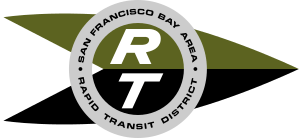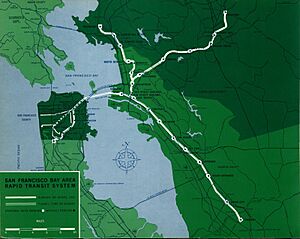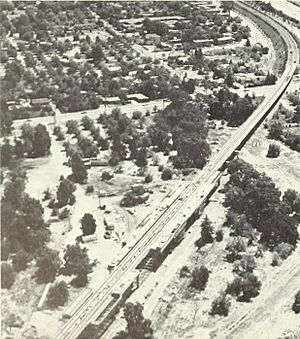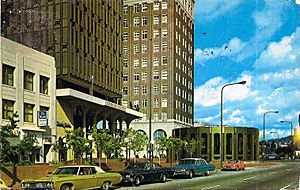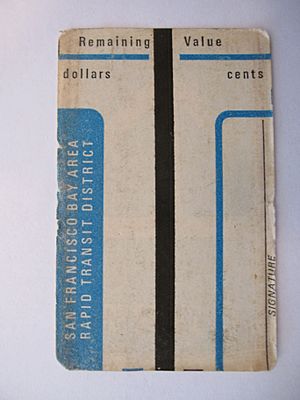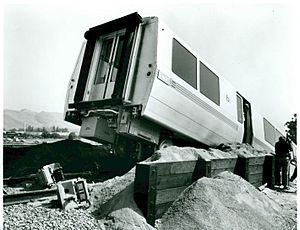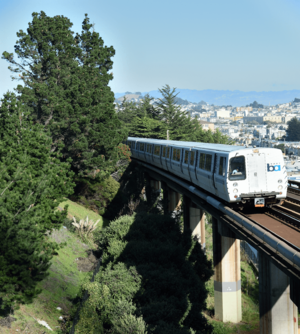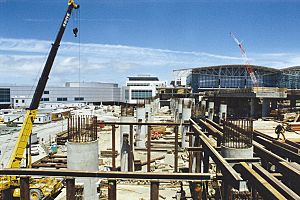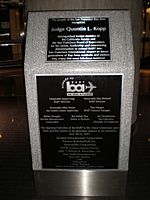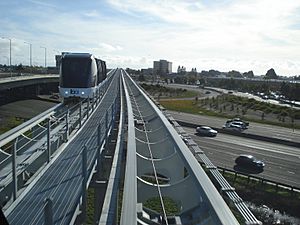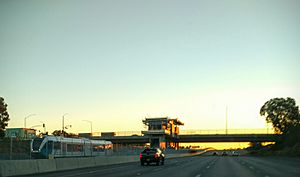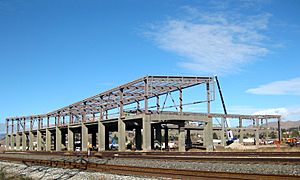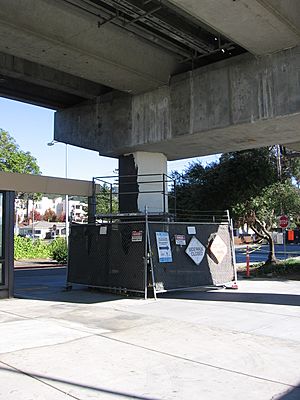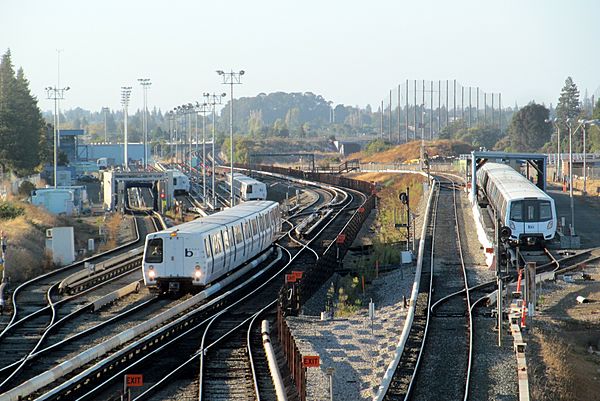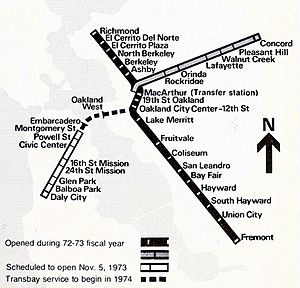History of Bay Area Rapid Transit facts for kids
Bay Area Rapid Transit, known as BART, is the main train system for the San Francisco Bay Area. People started thinking about it in 1946, but building the original system began in the 1960s.
Contents
- How BART Started and Was Planned
- Building the First BART System (1964–1976)
- Loma Prieta Earthquake
- San Francisco International Airport Extension (1984–2003)
- New Train Lines (1995–2018)
- Silicon Valley Extension (2009–Present)
- New Trains (2012–Present)
- Modernization and COVID-19 (2019–Present)
- BART Workers and Strikes
- Incidents and Accidents
- Past Train Lines
- Timeline of BART's Growth
How BART Started and Was Planned
The idea of an underwater electric train tunnel was first suggested in the early 1900s. In 1900, the San Francisco Chronicle newspaper even had a front-page story about an electric subway. There were also plans for a special electric train line under Market Street in the 1910s.
A study in 1915 said that a fast train link between Oakland and Berkeley was "super important." It suggested new streetcar lines or elevated trains. Before BART, a system called the Key System used electric streetcars and trains. This system used to carry people across the lower deck of the San Francisco–Oakland Bay Bridge. The last trip was in 1958, and the system was taken apart for cars and buses.
After World War II, more people moved to the Bay Area, causing lots of traffic. Business leaders started talking about a modern train system in 1946. In 1951, California created the San Francisco Bay Area Rapid Transit Commission. This group studied what the Bay Area needed for transportation.
A company hired by the commission suggested a big train system in 1956. The commission's final report in 1957 said the best way to fix traffic was to create a transit district. This district would build and run a fast train system connecting cities and suburbs. Nine Bay Area counties were part of the first planning group.
The San Francisco Bay Area Rapid Transit District was officially formed in 1957. It included Alameda, Contra Costa, Marin, San Francisco, and San Mateo counties. Santa Clara County decided to focus on its roads first, so it wasn't part of the original BART District. In 1959, a law was passed to pay for the underwater tube using extra money from the Bay Bridge tolls. This covered a big part of the system's total cost.
By 1961, a plan for the new system was sent to the leaders of the five counties. These plans included three train lines crossing the San Francisco Bay. They would connect Concord, Richmond, and Fremont. There was also a plan to cross the Golden Gate to Novato in Marin County. Another line would run along the Peninsula from Palo Alto.
However, in 1962, San Mateo County decided not to join. They said it was too expensive, and they already had train service from Southern Pacific. This left Daly City as the end of the line in the southwest. Marin County also left soon after. This was because of engineering concerns from the Golden Gate Bridge board and worries that voters wouldn't approve the funding. In 1962, the final plan was approved by voters in the three remaining counties.
Berkeley first approved a mix of underground and elevated train lines. But residents later wanted the entire line to be underground. After many meetings, the city voted to tax themselves to pay for the underground tunnel. This cost $20 million and delayed the system's completion.
New Train Technology Choices
BART was one of the first brand-new rapid transit systems built in the 20th century. Its designers wanted to create a system that other cities would want to buy. This led to some unique design choices.
The tracks were designed to be wider than usual in the United States. This wider track was chosen for better stability and a smoother ride. The trains also use flat-edge rails and wheels. The electrical system uses 1,000 volts of direct current from a third rail. This voltage is also unusual compared to other train systems.
These unique design choices have made maintaining BART more complex and costly. The trains need special wheels, brakes, and power systems.
Building the First BART System (1964–1976)
BART construction officially started on June 19, 1964. President Lyndon Johnson attended the groundbreaking ceremony. This happened on a test track between Concord and Walnut Creek. The system was planned to be finished in 1971.
Building BART involved huge tasks. They had to build three underground stations in downtown Oakland and three (later four) under Market Street in San Francisco. There were also other underground stations in San Francisco and three in Berkeley. New maintenance areas were also built.
The 3.2-mile (5.1 km)-long Berkeley Hills Tunnel was built through active earthquake faults. This helped avoid using another tunnel.
The most important part of the system was the 3.6-mile (5.8 km)-long Transbay Tube. This tube connected Oakland and San Francisco under the San Francisco Bay. It was the longest and deepest underwater tunnel in the world when finished in 1969. It cost $180 million. The tube was built in 57 sections. Each section was sunk into a dug-out trench across the bay and then covered.
BART built its tracks along existing rail lines and highways. These included parts of the Sacramento Northern Railway and Western Pacific Railroad. They also used parts of State Route 24 and Interstate 980. The last spike for the original system was placed in 1971.
BART Opens for Service
BART service began on September 11, 1972. More than 100,000 people rode BART in its first five days. The Market Street Subway opened on November 3, 1973. The Transbay Tube finally opened on September 16, 1974. This connected the four lines to Daly City, Concord, Richmond, and Fremont.
At first, BART ran 14 hours a day, only on weekdays. Saturday trains started in November 1977, and Sunday trains in July 1978. By 1976, BART had reduced 44,000 car trips. However, this was less than expected. One reason might have been that riders found it hard to get to stations, especially by walking.
The original BART system, including trains and the Transbay Tube, cost about $1.586 billion by 1976. Critics have said BART took a long time to build and was very expensive.
Embarcadero Station
Embarcadero Station The Embarcadero station opened on May 27, 1976. This was three years after the other San Francisco stations. It wasn't part of the first plans. But because the lower Market Street area was growing, the station's basic structure was added during construction. This allowed it to open later.
Automated Trains
BART was one of the first U.S. train systems to have a lot of automated operations. When it first opened, the automation system had many problems. Soon after service began, a test train went off the end of the elevated track at Fremont station and into a parking lot. This event was called the Fremont Flyer. Luckily, no one was seriously hurt.
The system that controlled the trains was developed by Westinghouse. When service started, "ghost trains" often appeared on the computer system. These were trains that showed up but didn't actually exist. Real trains could also disappear from the system. This happened because of dew on the tracks and low voltage. When this occurred, trains had to be driven manually at a slower speed.
Improvements were made to the train control system to fix these "ghost trains." However, for several years, operators had to manually keep trains in stations until the train ahead had left. This caused a lot of public discussion and legal fights between Westinghouse and BART. Over time, these problems were solved, and BART became reliable.
The original fare card system was also easy to hack. Most of these flaws have now been fixed. Train operations were first managed from a central control room. This was later replaced by a more modern Operations Control Center (OCC) in Oakland.
Train Control Problems
Before BART started carrying passengers, engineers found serious problems with the Automatic Train Control (ATC) system. Three engineers told BART management about safety concerns in 1969–1971. BART management didn't listen, so the engineers told the board of directors. Most directors supported management and ignored the safety worries. BART management then fired the engineers in March 1972.
The California Society of Professional Engineers told the California State Senate in June 1972 that the ATC had serious safety risks. An investigation started immediately.
An ATC failure caused the "Fremont Flyer" accident in 1972. A train ran off the elevated track and crashed, injuring four people. This accident got attention from all over the country and the world. It led to a complete redesign of the train controls. The California State Public Utilities Commission started closely watching train operations.
A report in November 1972 said BART's ATC system was unreliable and poorly managed. It also said there was "no solution in sight." BART's general manager called the safety concerns "deplorable." At the same time, management decided the ATC "could not now be trusted." So, automatic controls were stopped. Train movements were then managed by phone calls between stations.
The California State Senate and other groups started their own investigations. Several managers were replaced. The general manager was forced to resign in May 1974. State lawmakers also replaced the appointed board of directors with an elected one in 1974. These train control problems and management issues delayed the start of service to San Francisco from 1973 to 1974.
In 1978, the engineers who spoke up received an ethics award. The "BART Case" is now used as an example in courses about engineering ethics.
Loma Prieta Earthquake
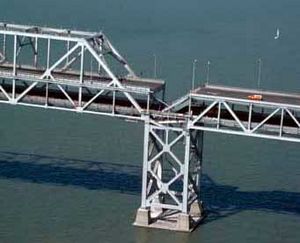
1989 Loma Prieta earthquake The 1989 Loma Prieta earthquake damaged the San Francisco–Oakland Bay Bridge and other roads. Many Bay Area freeways were broken. But BART trains were running again within five hours of the earthquake. Full service started at 5 AM the next day. Even with stops for safety checks after smaller aftershocks, BART ran 24 hours a day until December 3 of that year.
San Francisco International Airport Extension (1984–2003)
Plans for service south of Daly City were in the 1961 proposal. But San Mateo County leaving the planning district put these plans on hold.
Work to extend BART south from San Francisco began in 1984. This expansion was possible because San Mateo County agreed to pay $200 million. This payment was a "buy-in" to the system, even though they didn't officially join the BART district.
Service into San Mateo County (beyond Daly City) started in 1996 with the opening of Colma station. At that time, there wasn't enough money for the full airport extension. This station was the end of the line for over seven years.
Construction for the airport project started in November 1997. Four new stations were added: SFO station, South San Francisco, San Bruno, and Millbrae. The Millbrae station has a special connection to Caltrain trains. The $1.5 billion extension to San Francisco International Airport (SFO) opened on June 22, 2003.
The airport extension added 8.7 miles (14.0 km) of new railway. This included 6.1 miles (9.8 km) of subway, 1.2 miles (1.9 km) of elevated track, and 1.4 miles (2.3 km) at ground level.
However, the project had problems. The SFO extension only had about 35,107 daily riders by 2008. This was much less than the expected 50,000. Another big problem was the difficult relationship between BART and San Mateo County Transit District (SamTrans). SamTrans was responsible for the extension's operating costs. The extension wasn't making enough money, leading to arguments over bus and train service changes.
BART wanted to increase service to attract more riders. SamTrans wanted to reduce service to save money. So, service along the extension changed many times. Eventually, SamTrans paid BART $32 million, plus about $2 million a year. BART then took over all costs and control of running the extension.
Because of the low passenger numbers and the disagreements, BART changed its routes south of Daly City many times between 2003 and 2010. Finally, in 2010, BART decided that Pittsburg/Bay Point trains would go to SFO at all times. During busy weekday hours, Richmond trains go directly to Millbrae without stopping at SFO. In 2019, a shuttle train between SFO and Millbrae was brought back on weekdays and Sundays.
New Train Lines (1995–2018)
Some of San Mateo's "buy-in" money was used for new lines in the East Bay. Trains to North Concord/Martinez started in 1995, and to Pittsburg/Bay Point in 1996. In 1997, a new line to Castro Valley and Dublin/Pleasanton opened. This line was built in the middle of Interstate 580.
To save money, two new lines were built using different technologies. They are not like the main BART trains. The Oakland Airport Connector replaced a bus service and connected the airport to BART's fare system. This line uses automated, cable-drawn cars that run on rubber tires. It opened in 2014.
eBART was created to serve communities in eastern Contra Costa County. It uses standard train tracks and diesel trains. This allowed BART to build the line for 60% less cost than a traditional BART line. They can change it to electric trains later if needed. This service started in 2018 and includes a stop at Pittsburg Center station.
West Dublin / Pleasanton Station
The West Dublin / Pleasanton station was planned from the start of the Dublin/Pleasanton extension. Its foundation and some equipment were already there. Final construction began in 2006, but problems delayed its opening until 2011. It cost about $106 million.
There have been proposals to extend the line further east to Livermore. In 2017, the Livermore City Council suggested a new local group build the extension. This group, the Tri-Valley-San Joaquin Valley Regional Rail Authority, was created to plan and build train connections. Money previously set aside for BART to build the Livermore extension was given to this new group.
Silicon Valley Extension (2009–Present)
Silicon Valley BART extension Santa Clara County was supposed to be part of the BART district at first. But local leaders voted against it. In 2000, Santa Clara County voters approved a sales tax increase to pay for a BART extension to San Jose.
Construction of the Warm Springs extension began in 2009. It was planned to open in 2014, but it finally opened on March 25, 2017. The extension to Berryessa started construction in 2012.
Earthquake Safety
Even though BART handled the 1989 Loma Prieta earthquake well, a 2010 study showed that some overhead structures could collapse in a big earthquake. This led to necessary upgrades to make them stronger against earthquakes. One area, where the Berkeley Hills Tunnel crosses the Hayward Fault Zone, will be fixed after a large earthquake.
An earthquake early warning system called ShakeAlert was started in 2012. This system links BART to 200 seismic stations. These electronic signals travel faster than earthquake waves. For earthquakes outside the Bay Area, they give early notice that shaking is coming. For quakes in the Bay Area, they give an even earlier warning. If the system warns of strong ground motion, train computers will slow trains down.
BART Board President John McPartland said, "The earthquake early warning system will allow BART to stop trains before earthquake shaking starts. This will prevent derailment and save passengers from potential injuries." BART is the first transit agency in the U.S. to use this system.
The 3.6-mile (5.8 km) Transbay Tube also needed earthquake upgrades. The tube lies in a shallow trench at the bottom of San Francisco Bay. It was anchored by packing mud and gravel around it. This fill could turn to liquid during an earthquake, allowing the tube to break loose. Outside the tube, the fill was compacted to make it denser. Inside, BART installed heavy steel plates to reduce sideways movement. This work was done between March and December 2013. BART closed one of the two tunnels early on some weeknights. Trains shared a single tunnel, causing delays. The work was finished faster than expected.
New Trains (2012–Present)
As the main train fleet got older than 40 years, BART decided to replace all its cars. In 2012, BART gave a $900 million contract to Bombardier Transportation for 410 new cars. Later, BART bought 365 more cars, making a total of 775. This also sped up the delivery schedule.
The first 10-car test train was supposed to arrive in 2015. But due to possible access issues for people with disabilities, the car layout was changed in 2015. This added wheelchair spaces and flexible open areas. The delivery of the test train was delayed until late 2016. This train started carrying passengers on January 19, 2018.
The first 140 cars were set to start service in 2017, but this number was cut to 54. Delivery of all 775 cars was delayed from 2021 to 2022. By November 2018, 45 new cars were in use. BART also announced they could buy up to 1,200 cars in total.
Modernization and COVID-19 (2019–Present)
To speed up earthquake upgrades for the Transbay Tunnel, BART changed its schedule on February 11, 2019. Weekday trains now start around 5:00 am, later than the previous 4:00 am start. Special express bus services were created or expanded for early riders. Also, weekday evening service was reduced to allow for construction work in one track of the Tube. The SFO–Millbrae line was brought back. Sunday service to San Francisco resumed on February 16, 2020.
During the COVID-19 pandemic, ridership dropped by 90%. This led to reduced service hours and longer train lengths to allow for social distancing. By February 2021, ridership was still below 20% of normal levels.
BART Workers and Strikes
BART workers are part of four different unions.
- 1976 Strike
BART workers went on strike for two weeks in 1976 to support the BART Police Officers Association. During the 1970s, BART union workers received pay increases every three months based on living costs.
- 1979 Lockout/Strike
In 1979, there was a 90-day lockout by management or a strike by union workers. Trains still ran because one union was not formally organized, and management had enough staff. After this, cost-of-living increases were greatly reduced.
- 1997 Strike
For seven days in September 1997, a BART strike caused the whole system to shut down. This led to a four-year contract with a seven percent raise and a one-time payment of $3,000 for employees. BART also started laying off many workers, increasing the work for those who remained.
- 2001 Negotiations
In 2001, BART unions fought for and won a 24 percent wage increase over four years. They also kept benefits for employees and retirees.
- 2005 Negotiations
Another threatened strike in 2005 was avoided with a last-minute agreement. Union workers received a 7% raise over four years but paid more for medical insurance. The net increase was below inflation.
- 2009 Negotiations
The 2009 contract negotiations resulted in a four-year wage freeze, reduced pensions, and changes to work rules. These new terms saved BART $100 million from 2009 to 2013.
- 2013 Strikes
BART employees went on strike on July 1, 2013, over pay and safety issues. The strike ended on July 5. A second strike began on October 18, 2013, over pay and work rules. Management offered a 12% wage increase, but unions wanted binding arbitration for work rules, which management refused.
Awards for BART
In 1997, BART was named a Historic Mechanical Engineering Landmark. It was called the "most advanced automated urban rail transit system."
In 2004, BART received the Outstanding Public Transportation System Award for transit systems with over 30 million passengers a year. BART announced it had been named Number One Transit System in America. In 2006, BART also won an award for its creative marketing, including an iPod-based trip planner.
Incidents and Accidents
There have been no accidents caused by brake failure. Here are some incidents that have happened on the BART system:
- In 1972, a test train went off the track at Fremont and into a parking lot. Several people were injured.
- The Transbay Tube was closed from January to April 1979 after a train caught fire. Dozens were injured, and a firefighter died. The fire damaged equipment.
- In 1992, a BART train went off the tracks near 12th Street station in Oakland. This closed the line for five days.
- In 2006, debris on the tracks caught fire, causing a 1.5-hour system-wide shutdown.
- In March 2006, computer problems during rush hour left about 35,000 commuters stuck.
- In December 2006, a BART train went off the tracks near the Oakland Wye. No one was injured.
- In May 2008, two fires at power stations disrupted service on the Fremont line. No injuries were reported.
- In October 2008, a BART track worker was killed by a train near Concord.
- In December 2008, an electrical fire broke out near Walnut Creek station. This caused major delays.
- In January 2009, an officer-involved shooting occurred at the Fruitvale station, resulting in a death.
- In February 2009, two trains collided at low speed, injuring a dozen people.
- In July 2009, a train hit a construction worker. No passengers were hurt.
- In December 2009, a train went off the tracks between Lake Merrit and 12th Street stations.
- In March 2011, two cars of a train went off the tracks after leaving Concord station. Three minor injuries were reported. A similar event happened in February 2014.
- In October 2013, two BART workers were killed while inspecting a track section.
- In April 2016, a new test car went off the end of a track during tests. No one was injured.
- In February 2017, a train hit a person on the Richmond line, and the person died.
- In September 2021, a woman died at the Powell Street Station when a train door closed on her pet's leash, which was tied around her waist.
Past Train Lines
For about ten months, the San Francisco part of BART operated as its own separate line. This was between the opening of the Market Street Subway and the Transbay Tube.
From 1995 to 1997, BART ran limited direct service between Concord and Bay Fair. This was to help with traffic during road construction.
AirBART, a special bus line, used to run between the Coliseum station and the Oakland International Airport. This service stopped in 2014 when the Coliseum–Oakland International Airport line opened.
The SFO–Millbrae line (Purple Line) operated twice as a shuttle service between San Francisco International Airport and Millbrae. The first time was from 2003 to 2004. The shuttle service started again in 2019 but was replaced by other services in 2021.
Timeline of BART's Growth
| Segment description | Date opened | Line(s) | Endpoints | # of new stations |
Length (miles) |
|---|---|---|---|---|---|
| Initial service | September 11, 1972 | MacArthur to Fremont | 12 | 28 | |
| Richmond service | January 29, 1973 | Richmond to MacArthur | 6 | 11 | |
| Concord service | May 21, 1973 | Concord to MacArthur | 6 | 17 | |
| San Francisco service | November 5, 1973 | Montgomery Street to Daly City | 8 | 7.5 | |
| Transbay Tube (M-Line) | September 16, 1974 | Oakland Wye to Montgomery Street | 1 | 8 | |
| Original system | 33 | 71.5 | |||
| Embarcadero (infill station) | May 27, 1976 | 1 | 0 | ||
| North Concord/Martinez extension | December 16, 1995 | North Concord/Martinez to Concord | 1 | 2.5 | |
| Colma extension | February 24, 1996 | Colma to Daly City | 1 | 1.6 | |
| Pittsburg/Bay Point extension | December 7, 1996 | Pittsburg/Bay Point to North Concord/Martinez | 1 | 5.3 | |
| Dublin/Pleasanton extension | May 10, 1997 | Bay Fair to Dublin/Pleasanton | 2 | 14.7 | |
| San Francisco Airport extension | June 22, 2003 | Colma to SFO/Millbrae | 4 | 8.7 | |
| West Dublin/Pleasanton (infill station) | February 19, 2011 | 1 | 0 | ||
| Oakland Airport Connector | November 22, 2014 | Coliseum to Oakland International Airport | 1 | ||
| Warm Springs extension | March 25, 2017 | Warm Springs/South Fremont to Fremont | 1 | 5.4 | |
| eBART | May 26, 2018 | Antioch to Pittsburg/Bay Point | 2 | §10.1 | |
| Silicon Valley extension Phase 1 | June 13, 2020 | Warm Springs to Berryessa | 2 | 10 | |
| TOTAL | 50 | 129.8 §10.1 |
|||
| Silicon Valley extension Phase 2 | 2029–2030 (planned) | Santa Clara to Berryessa | 4 | 6 | |
![]() Automated guideway transit line
Automated guideway transit line
§ Standard gauge track


